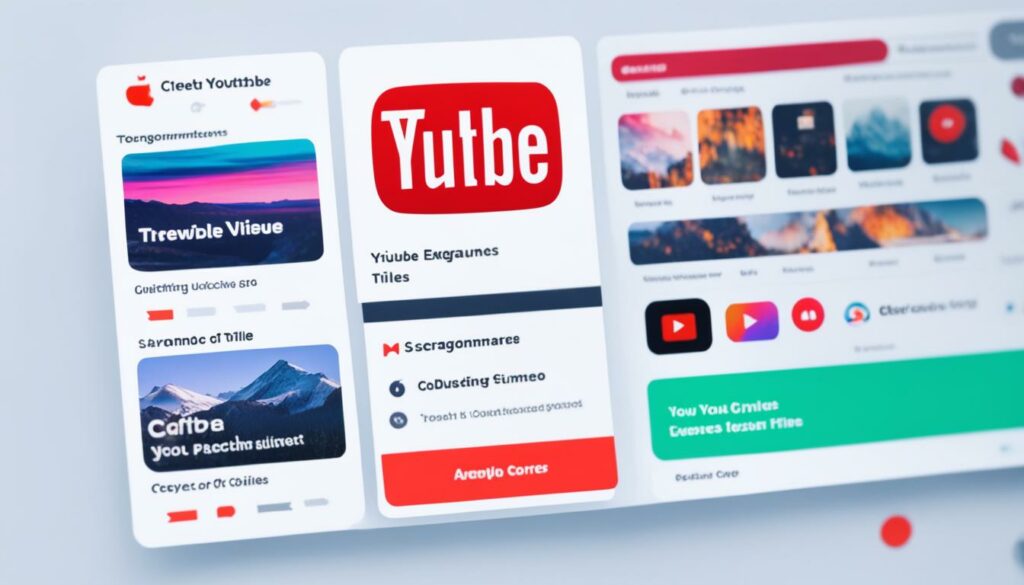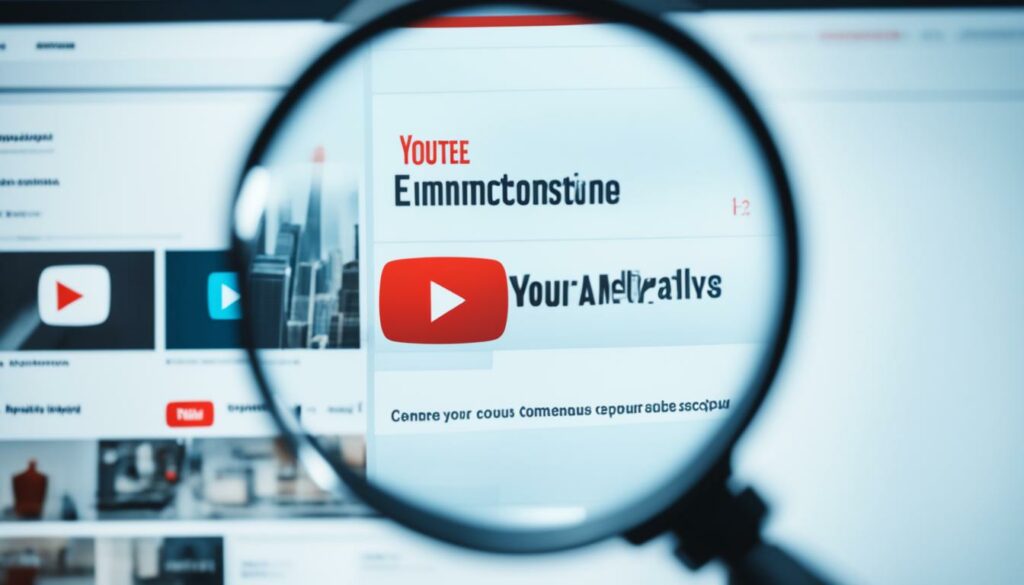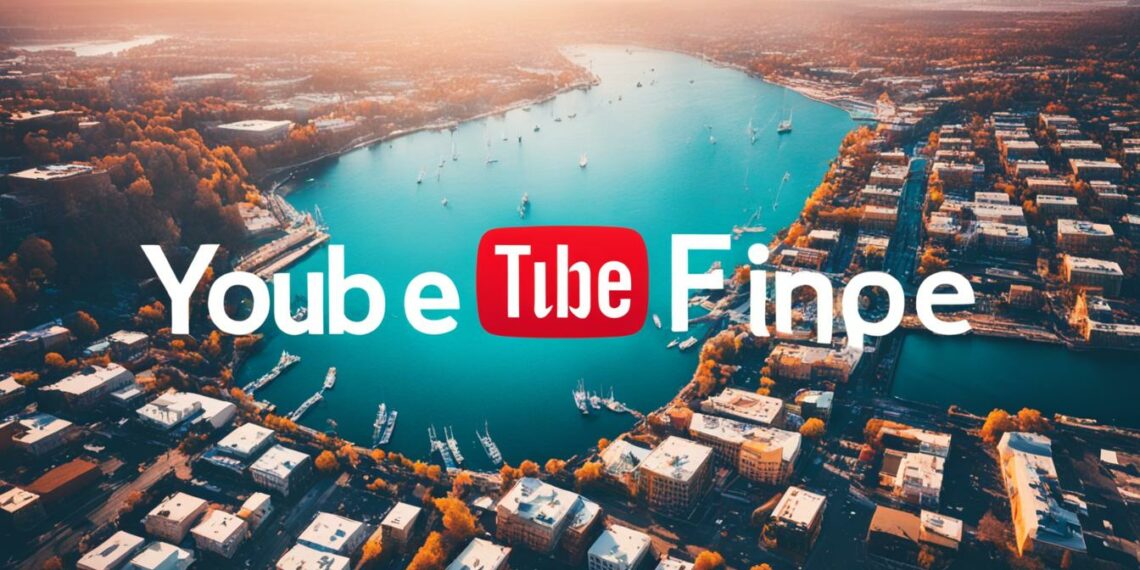Did you know nearly 500 hours of video content is uploaded to YouTube every minute? In this huge sea of videos, making catchy YouTube titles is key to standing out. Your title is like the door to your video, crucial for drawing in viewers and making your video more visible. It’s important to match your titles with what your video aims to do—entertain, teach, or inspire.
Learning how to make engaging YouTube titles can really boost your channel’s success. Knowing your audience, using strong keywords, and being creative are important YouTube title best practices. These tips help you connect better with your viewers.
Key Takeaways
- YouTube titles should be concise, ideally between 60-70 characters for optimal display.
- Using numerals in titles can attract more viewer attention.
- Avoid clickbait; ensure your title accurately reflects the content.
- Incorporate emotive words to influence viewer interest subconsciously.
- Studying competitors can inspire effective title crafting strategies.
- Numbers and urgency in titles can enhance engagement rates.
Why YouTube Titles Matter for Video Success
YouTube titles are the first thing people see when they come across your video. With over more videos uploaded every 30 days than major U.S. TV networks made in the last 30 years, the competition is fierce. This shows how crucial YouTube titles are in making people decide to watch your video or not.
Optimizing your video titles helps people find your content easier. Studies show that videos with titles that match what people are searching for might get a small boost in ranking. This might not be a lot, but it shows how important it is to use the right keywords. Using keywords well can greatly improve how visible your video is on YouTube.
Videos that rank high often have titles with the exact keywords early on. This is key for SEO, as titles affect how your video ranks on YouTube and Google. A good title that sums up your video’s value can lead to more people watching it and engaging with it. This can make your video more likely to be recommended to others.
Great titles do more than just help with rankings; they make for a better experience for viewers. Titles that grab emotions can get more clicks and shares, which helps your video reach more people. But, remember, clickbait titles can hurt your chances of being shown to new viewers. After people click, how they interact with your video—by liking, commenting, or sharing it—is very important. It shows how engaged they are with your content.
In short, paying attention to YouTube titles and optimizing them well can really help your video stand out and get more viewers. As YouTube changes, adjusting your strategy can keep you relevant and help you grow.
Understanding the Character Limit for YouTube Titles
YouTube is the second-largest search engine worldwide, making it crucial to craft the perfect title. The platform allows titles up to 100 characters. However, the best titles are between 60 to 70 characters long. This length ensures they show fully on all devices, especially mobiles, where short titles might be cut off.
Creating effective titles means using concise, informative language. It’s important to keep it engaging and within the recommended length. This approach not only draws in viewers but also helps meet YouTube’s algorithm for better visibility. Every character and word should add to the title’s relevance and appeal.
Considering these points, focusing on clear and brief titles can boost your video’s success. By creating titles within the given limits, you improve your content’s visibility on the platform. This leads to more viewer engagement and higher click-through rates.
How to Create Engaging YouTube Titles
Making your YouTube video titles clear is key to getting viewers. A simple approach is best when making titles engaging. Clear titles set the right expectations for viewers, showing them what your video is about.
This clarity can boost engagement and keep viewers watching. If your title matches the video’s topic, it draws more viewers in.
The Importance of Clarity
Writing titles that capture the video’s core is crucial. For example, educational videos might start with “How to…,” while fun videos use catchy language. Knowing what your audience likes helps you craft better titles.
Clear titles avoid misleading viewers and draw in those interested in the topic. This makes them more likely to watch your video.
Setting Viewer Expectations
What viewers expect affects how they react to your video. It’s important to match your title with what the video offers. This keeps viewers interested and engaged.
Using strong words like “amazing” or “mind-blowing” makes titles clearer and more appealing. Adding numbers, like “10 Must-Know Tips,” creates a sense of urgency. This encourages viewers to click on your video.
Adding details like “[Tutorial]” or “[For Kids]” makes your title clearer. Think of your title as a foundation for engaging with viewers. The more direct and relevant your title, the more it will connect with your audience.
By combining these tips, you can make titles that grab attention and stand out on YouTube. With over 500 hours of new content uploaded every minute, being clear and engaging is key to success.
In the world of YouTube, using the right keywords is key. These keywords for YouTube help people find your videos and make your titles better. To start optimizing your titles, do deep research to find terms that your audience likes and keeps them engaged.
Conducting Keyword Research
Keyword research is vital to grab the attention of viewers. Tools like vidIQ or TubeBuddy can show you popular phrases with less competition. Look at top-ranked videos to see what keywords work well. Think about these points when researching:
- Identify trending topics within your niche.
- Look for questions commonly asked by users.
- Examine titles of popular videos for inspiration.
Incorporating Keywords Naturally
It’s key to add keywords to your titles but keep it natural to keep viewers interested. Put main keywords at the start to help with search results. Aim for titles under 70 characters, about 6-10 words long. This helps keep viewers watching and makes your titles better for search engines and people.
- Incorporate the keywords for YouTube smoothly.
- Avoid forced or awkward phrasing.
- Make potential viewers curious about your content.

| Aspect | Importance |
|---|---|
| Keyword Placement | Boosts visibility and relevance |
| Character Limit | Under 70 characters for best effect |
| Search Traffic | 20% to 40% of views come from searches |
| Engagement | More interaction means better rankings |
Strategies for Crafting Catchy YouTube Titles
Creating catchy YouTube titles is key to getting more viewers. Using numbers and adding a sense of urgency are two great strategies. These methods make people curious and more likely to watch your video.
Using Numbers for Impact
Adding numbers to your title can really help get more clicks. Phrases like “Top 10,” “5 Tips,” or “7 Ways” grab attention and show what your video is about. Studies show that titles with numbers seem more trustworthy to viewers.
This makes people more likely to watch. Videos that answer questions with “How,” “What,” or “Why” and include numbers get a lot of clicks. People want to learn new things.
Creating a Sense of Urgency
Titles that make viewers feel like they need to act fast work well. Using phrases like “Watch Now” or “Limited Time Only” taps into emotions. It makes people want to click to get the info quickly.
Adding words like “amazing” or “unbelievable” to your title can make it even more compelling. This makes viewers want to watch your video right away. Trying out different titles helps you see what works best.
| Strategy | Description | Impact on Engagement |
|---|---|---|
| Using Numbers | Incorporating numeric values into titles. | Increases curiosity and perceived credibility. |
| Creating Urgency | Utilizing time-sensitive phrases to incite action. | Encourages immediate clicks and emotional engagement. |
| Emotive Words | Implementing powerful descriptive language. | Enhances viewer interest and relatability. |
| Testing Variations | Performing A/B tests on titles. | Refines engagement strategies for optimal clicks. |
Avoiding Clickbait: Setting Realistic Expectations
YouTube has over 2.5 billion monthly users, making it a key spot for videos. You want to grab attention without using clickbait. Using realistic video titles builds trust with viewers. False titles might get more views at first but can hurt your channel’s image later.
Titles that are enticing yet honest keep viewers coming back. For example, a video on real estate investing by Bigger Pockets got a million views with a clear title. On the other hand, misleading titles might attract clicks but could lose you subscribers. This shows the choice you have: go for more views with tricks or focus on honest titles that offer real value.
Consider how your titles affect keeping viewers around. A video by Chevy Dude, with nearly six million views, used a detailed title. Realistic titles help keep a steady subscriber base. This approach makes your audience more loyal.
To find the best channel ideas without showing your face, check out this resource. Choosing authenticity over tricks helps your channel grow and stay trustworthy in a crowded online world.
Enhancing Titles with Emojis and Symbols
Using emojis in titles grabs attention in a crowded space. With over 500 hours of video uploaded every minute on YouTube, standing out is crucial. Relevant emojis can greatly increase click-through rates (CTR), which helps improve search rankings by boosting engagement.
Taja’s AI analytics helps find the best emojis for your content and audience. Using emojis consistently can make your brand more recognizable. Seeing how well titles with emojis perform gives creators insights to improve their strategies.
It’s important to use title symbols and emojis wisely. Too many can make your title look cluttered or like a gimmick. Good titles are short, around 60 to 70 characters, which helps with visibility and engagement on mobile devices.
Try different emojis to see what works best with your audience. This helps improve your YouTube titles and starts more meaningful conversations with viewers. Understanding the importance of emojis in your titles can make your content more engaging and appealing to your audience.
Studying Your Competitors: Learning from the Best
Looking at your competitors can change the game for your YouTube titles. By studying successful titles, you can spot strategies that work well in your area. Start by finding top videos and check their title styles, keyword use, and how viewers interact with them.
Tools like CoSchedule’s free YouTube Title Generator can help make catchy and SEO-friendly titles. This tool lets you add keywords, think about your audience, and choose a tone. It helps match your titles with what people expect.
Testing different title versions is key to seeing which ones get more attention. Look at what top competitors often use in their titles to avoid being too common. Using trending topics can make your titles more visible, so keep up with what’s popular.
Adding voice search optimization by using everyday phrases and questions in your titles is smart. Knowing what users want is more important than just how many search for it. With over 2.70 billion YouTube users, you have a huge audience that’s growing. By 2025, this number is expected to hit 2.85 billion.
Deep dive into 5-10 competitor channels to learn more. Look at their video topics, content types, when they post, and how they engage with their audience. Being active in the community, like answering comments and working with other creators, can really boost viewer interaction and loyalty.

By gathering and analyzing competitor data, you can spot common themes and trends. This helps you stay ahead and make titles that appeal to your audience.
| Competitor Channel | Video Topics | Engagement Strategies | Popular Video Titles |
|---|---|---|---|
| Channel A | Health & Wellness | Responds to comments regularly | “10 Tips for a Healthier Life” |
| Channel B | Technology Reviews | Collaborates with influencers | “The Best Gadgets of 2025” |
| Channel C | Travel Vlogs | Frequent Q&A sessions | “Exploring Hidden Gems of Asia” |
| Channel D | Culinary Arts | Interactive cooking challenges | “5 Easy Recipes for Beginners” |
| Channel E | Fitness Tips | Offers viewer shoutouts | “Transform Your Body in 30 Days” |
Conclusion
When you start on YouTube, it’s key to remember how to craft great titles. A good title makes your video stand out and matches well with YouTube’s title strategies. Focus on being clear, using the right keywords, and making titles that connect with your audience. This sets you up for a successful channel.
This recap covered important tips like using keywords well and making titles that grab attention. We also talked about YouTube engagement tips to help you make titles that keep viewers hooked. Remember, finding the right mix of creativity and clarity is key.
Refining your skills and knowing your audience well will help you make titles that draw in viewers and keep them coming back. The right title can make your channel more visible and help it grow. It also keeps viewers loyal. Staying committed to improving will help you stand out in the crowded world of content creation.
FAQ
Why are engaging YouTube titles important?
Engaging YouTube titles are key because they help users decide what to watch. They increase clicks and views. This helps your channel grow and makes your content easier to find.
What is the ideal character limit for YouTube titles?
YouTube titles can be up to 100 characters long. But, it’s best to keep them between 60 and 70 characters. This makes them visible on all devices, especially mobile.
How can I ensure my titles are clear and informative?
Make sure your titles clearly show what the video is about. They should also set the right expectations for viewers. Being clear helps keep people interested.
What keywords should I include in my YouTube titles?
Use keywords that match your content and are searched a lot. Tools like vidIQ can show you which keywords your audience likes.
How can I create urgency in my titles?
Use phrases like “Watch Now” or “Limited Time Only” to make titles more urgent. This encourages viewers to click fast for special offers.
Is using emojis in titles effective?
Yes, emojis can make titles stand out and grab attention. But, use them carefully to keep your titles professional and clear.
How can I learn from my competitors when crafting titles?
Look at successful videos in your area to see what makes their titles work. Notice their style, keywords, and how well they engage viewers. This can help you find good strategies.
What are some best practices for title crafting?
Good title crafting means being clear, using the right keywords, and avoiding clickbait. Your titles should still be catchy and truly represent your video’s content.




